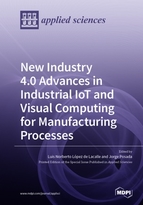New Industry 4.0 Advances in Industrial IoT and Visual Computing for Manufacturing Processes
A special issue of Applied Sciences (ISSN 2076-3417). This special issue belongs to the section "Applied Industrial Technologies".
Deadline for manuscript submissions: closed (15 August 2019) | Viewed by 105462
Related Special Issue: New Industry 4.0 Advances in Industrial IoT and Visual Computing for Manufacturing Processes: Volume III
Special Issue Editors
Interests: manufacturing process
Special Issues, Collections and Topics in MDPI journals
Interests: Industry 4.0; visual computing; computer graphics; simulation; knowledge engineering
Special Issues, Collections and Topics in MDPI journals
Special Issue Information
Dear Colleagues,
Today, industrial factories are experiencing a rapid digital transformation because of the introduction of emerging ICT technologies, such as the industrial Internet of things (IIOT), industrial big data and cloud technologies, deep learning and deep analytics, artificial intelligence, intelligent robotics, cyber-physical systems, digital twins, and visual computing (including augmented reality, visual analytics, cognitive computer vision, new HMI interfaces, and simulation and computer graphics), among others. This is evident in the global trend of Industry 4.0 and related initiatives, which are present in one way or another in many different production strategies at an international level (Industrie 4.0, Germany; industrial Internet, USA; Industrie du Futur, France; made in China 2025, China; etc.).
In the context of high performance manufacturing, the impact of these technologies is clear. Important improvements can be achieved in the productivity, systems reliability, parts quality, and human welfare.
Both classical and new manufacturing processes (such as additive manufacturing), based on advanced mecahnical principles, are being enhanced by the use of big data analytics on industrial sensor data. In the current machine tools and systems, there are complex sensors that are able to gather useful information, which can be captured, stored, and processed with edge, fogor cloud computing technologies. Manufacturing processes modelling can lead to improvements in productivity and quality, and in several cases, are implemented by means of digital twins on cyber-physical production devices and systems.
In this line, the manufacturing process models (e.g. thermal, vibration, deformation, etc.) can be improved with digital monitoring, digital twins, visual data analytics, artificial intelligence, and computer vision in order to achieve a more productive and reliable smart factory.
On the other hand, the role of the human factor is absolutely fundamental in these new paradigms. Collaborative robots are spreading in several applications in order to work along with human skilful workers. New approaches for augmented reality and immersive virtual reality, as well as other multimodal ways of improving human computer interaction in manufacturing scenarios, are enhancing the capabilities of operators and engineers so as to capture and reproduce human knowledge, improve their performance in operational tasks, and seamlessly integrate their valuable experience and flexibility in smart factory scenarios for manufacturing. Visual analytics can help decision-making by management, domain experts, operators, engineers, and so on, by providing user-specific interactive visualization and the exploration of operational data in combination with machine learning approaches.
In summary, this Special Issue is an opportunity for the scientific community to present recent research regarding industrial IoT and visual computing as key aspects of Industry 4.0 for manufacturing processes.
Prof. Dr. Luis Norberto López de LacalleDr.-Ing. Jorge Posada
Guest Editors
Manuscript Submission Information
Manuscripts should be submitted online at www.mdpi.com by registering and logging in to this website. Once you are registered, click here to go to the submission form. Manuscripts can be submitted until the deadline. All submissions that pass pre-check are peer-reviewed. Accepted papers will be published continuously in the journal (as soon as accepted) and will be listed together on the special issue website. Research articles, review articles as well as short communications are invited. For planned papers, a title and short abstract (about 100 words) can be sent to the Editorial Office for announcement on this website.
Submitted manuscripts should not have been published previously, nor be under consideration for publication elsewhere (except conference proceedings papers). All manuscripts are thoroughly refereed through a single-blind peer-review process. A guide for authors and other relevant information for submission of manuscripts is available on the Instructions for Authors page. Applied Sciences is an international peer-reviewed open access semimonthly journal published by MDPI.
Please visit the Instructions for Authors page before submitting a manuscript. The Article Processing Charge (APC) for publication in this open access journal is 2400 CHF (Swiss Francs). Submitted papers should be well formatted and use good English. Authors may use MDPI's English editing service prior to publication or during author revisions.
Keywords
- Advanced manufacturing
- Industry 4.0
- Smart factories
- Visual computing
- Industrial Internet of things
- Cyber physical systems, and cyber-physical production systems
- Digital twins
- Edge, fog, and cloud computing
- Augmented reality
- 5G in manufacturing
- Deep analytics
- Industrial big data
- Workshop networks
- High performance manufacturing
- Manufacturing processes
- Machine and processes monitoring
- Knowledge-based manufacturing
- Advances in manufacturing processes
- Process modeling, process simulation
- Virtual manufacturing
- Artificial vision
- Virtual reality
- Collaborative robots
- Management in new digitally powered manufacturing concepts







